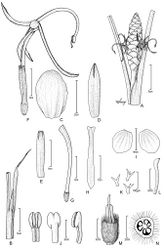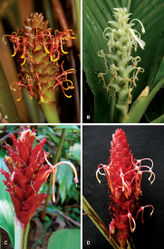Larsenianthus arunachalensis
| Notice: | This page is derived from the original publication listed below, whose author(s) should always be credited. Further contributors may edit and improve the content of this page and, consequently, need to be credited as well (see page history). Any assessment of factual correctness requires a careful review of the original article as well as of subsequent contributions.
If you are uncertain whether your planned contribution is correct or not, we suggest that you use the associated discussion page instead of editing the page directly. This page should be cited as follows (rationale):
Citation formats to copy and paste
BibTeX: @article{Kress2010PhytoKeys1, RIS/ Endnote: TY - JOUR Wikipedia/ Citizendium: <ref name="Kress2010PhytoKeys1">{{Citation See also the citation download page at the journal. |
Familia: Zingiberaceae
Genus: Larsenianthus
Name
Larsenianthus arunachalensis M. Sabu, Sanoj & T.Rajesh Kumar sp. nov. – Wikispecies link – IPNI link – Pensoft Profile
Latin
Species nova L. careyano affinis, a quo inflorescentia centrali in caule bifoliato portata et ad bracteam quamque floribus fertilibus 2–3 differt.
Type
India: Arunachal Pradesh: Lohit Dt.: Lalpani, Hayuliang Road, N 27°56'28.2", E 096°22'21.9", 6 August 2009, E.Sanoj & T.Rajesh Kumar 105640 (holotype: CAL!; isotypes: CALI!, ASSAM!).
Description
Evergreen herb, medium-sized to 150 cm tall; rhizome 1.9 cm in diameter, hard, fibrous, slightly aromatic, inner color pale brown; tubers absent. Leafy shoot erect; base 2.5–3 cm in diameter. Leaves two per flowering shoot, to 120 cm in total length; basal leaf sheaths 4–6, red and green, densely pubescent towards apex; petiole 19.5–31 cm in length, cross section U-shaped, pubescent, green; ligule 9.5–14 cm in length × 2.4–2.7 cm in width, lanceolate, apex attenuate, pubescent abaxially, becoming dry and brown; lamina 56–88 cm in length × 19–25 cm in width, abaxially pale green and densely pubescent with silvery hairs, elliptic, dark green, and glabrous above, veins raised 4–6 mm, margins entire, undulate, hyaline, white tinged, base attenuate, apex long acute, slightly twisted. Inflorescence terminal on leafy shoot, erect to 90 cm in height; apical part of peduncle 25–75 cm in length, c. 1.2 cm in diameter, pubescent, pale green; spike elliptic, 14–19 cm in height × 3–3.4 cm in diameter; inflorescence bracts 60–80 per inflorescence, bracts 2.4–2.9 cm in length × 2.6–2.8 cm in width, spirally arranged and tightly imbricate, orbicular to broadly elliptic, cymbiform, free to the base, coriaceous, deep red, base white tinged, margin entire and smooth, glabrous, apex acute to rounded, surfaces pubescent, dense brown hairs toward apex; one cincinnus per bract; bracteoles tubular, longer than bracts, 2.8–3.3 cm in length, unilaterally split 1 cm, apex acute to rounded, deep red, white tinged towards base, densely pubescent with short brown hairs towards apex. Flowers conspicuous, 2–4 per bract, 2–8 flowers open simultaneously on inflorescence; calyx tubular, 16–17 mm in length × c. 3 mm in width, apex trilobed, unilaterally split 5–6 mm, pale red, white towards base, pubescent with denser hairs towards apex, membranous, translucent; floral tube 3.2–3.3 cm in length × c. 3.5 mm in diameter at opening, red, lobed with each lobe 15–17 mm in length, oblanceolate, dorsal lobe reflex, sparsely pubescent externally with scattered unicellular branched hairs inside, lateral lobes glabrous; lateral staminodes c. 4 mm in length × 3.5 mm in width, orbicular to broadly elliptic, white with pale red tinge, revolute; labellum 25–28 mm in length × 2.5–3 mm in width, narrowly oblong in first two-thirds and oblanceolate distal third, semi-spathulate, red to creamy yellow towards base and orange-yellow towards acute, beak-like apex; fertile stamen with filament 2.4–2.6 cm in length, red becoming creamy-yellow near anther, arching like a fish-hook; anther c.3 mm in length × 2 mm in width, creamy yellow, glabrous; epigynous glands two, oblong, white, 2.5–3.0 mm in length; stigma c. 0.5 mm wide, white, bulbous, margins ciliate, exserted 2–2.5 mm from the middle of the anther; ovary trilocular, c. 3 mm in length × 2.5 mm in diamter, tomentose, pale red. Fruits and seeds unknown.
Distribution
Larsenianthus arunachalensis is narrowly endemic in Arunachal Pradesh, India, and is known only from the type locality. It is highly endangered due to various anthropogenic activities.
Ecology
This species grows in sandy soil above 1,400 m in elevation amidst thick clumps of wild species of Musa.
Etymology
The specific epithet “arunachalaensis” is derived from the name of the state in northeast India from where the type specimen was collected.
Specimens examined
Known only from the type specimen.
Original Description
- Kress, W; D. Mood, J; Sabu, M; Prince, L; Dey, S; Sanoj, E; 2010: Larsenianthus, a new Asian genus of Gingers (Zingiberaceae) with four species PhytoKeys, 1: 15-32. doi
Images
|

